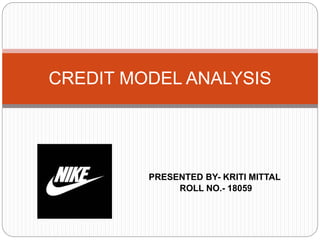This document provides an analysis of Nike's credit model. It includes an introduction to Nike as a company, an analysis of its cost of capital (WACC) of 3.34%, and historical returns on investment and returns on capital. The document also discusses Nike's expected growth areas, best case scenario of a 1% improvement in return on capital, and worst case scenarios involving rising costs and lower future orders. Risks discussed include competitive pressures and supply chain issues. The summary concludes that in a market slowdown, Nike's return on capital is expected to improve by 10%.

















